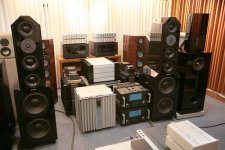jjovin
Established
I have to say that I "heard difference" 😀 between different interconnects.
I used to have a pair of relatively expensive MIT interconnects which I got for free
from a friend who was selling high end audio equipment.
Then I compared them with interconnects made of 12 gage electrical wire.
One day a few years back I could not pass
a sale of monster digital interconnects at radio shack for $12.
When I tested the digital ones as my analog interconnects,
it was clear that the sound stage was so well defines and it seemed like
I was looking through Zeiss glass.
So, I replaced all my interconnects with the $12 digital ones. I have strong doubts that any more expensive ones would sound better.
For completeness, my stereo system consists of
Linn turntable,
Conrad-Johnson tube amplifier and preamplifier,
Pro-Ac speakers and
CAL Icon CD player.
Coincidentally, I also own a Zeiss Ikon camera.
However, I spent many years listening to many different high end systems and there is difference in sound between other components (amps pre-amps, turntables ...).
One just has to decide if that difference is worth the money.
But I have no problem with people spending huge amounts of “their own” money 😉 on whatever they want, be it Leica or Krell.
Good listening in the new year,
Zoran
I used to have a pair of relatively expensive MIT interconnects which I got for free
from a friend who was selling high end audio equipment.
Then I compared them with interconnects made of 12 gage electrical wire.
One day a few years back I could not pass
a sale of monster digital interconnects at radio shack for $12.
When I tested the digital ones as my analog interconnects,
it was clear that the sound stage was so well defines and it seemed like
I was looking through Zeiss glass.
So, I replaced all my interconnects with the $12 digital ones. I have strong doubts that any more expensive ones would sound better.
For completeness, my stereo system consists of
Linn turntable,
Conrad-Johnson tube amplifier and preamplifier,
Pro-Ac speakers and
CAL Icon CD player.
Coincidentally, I also own a Zeiss Ikon camera.
However, I spent many years listening to many different high end systems and there is difference in sound between other components (amps pre-amps, turntables ...).
One just has to decide if that difference is worth the money.
But I have no problem with people spending huge amounts of “their own” money 😉 on whatever they want, be it Leica or Krell.
Good listening in the new year,
Zoran


